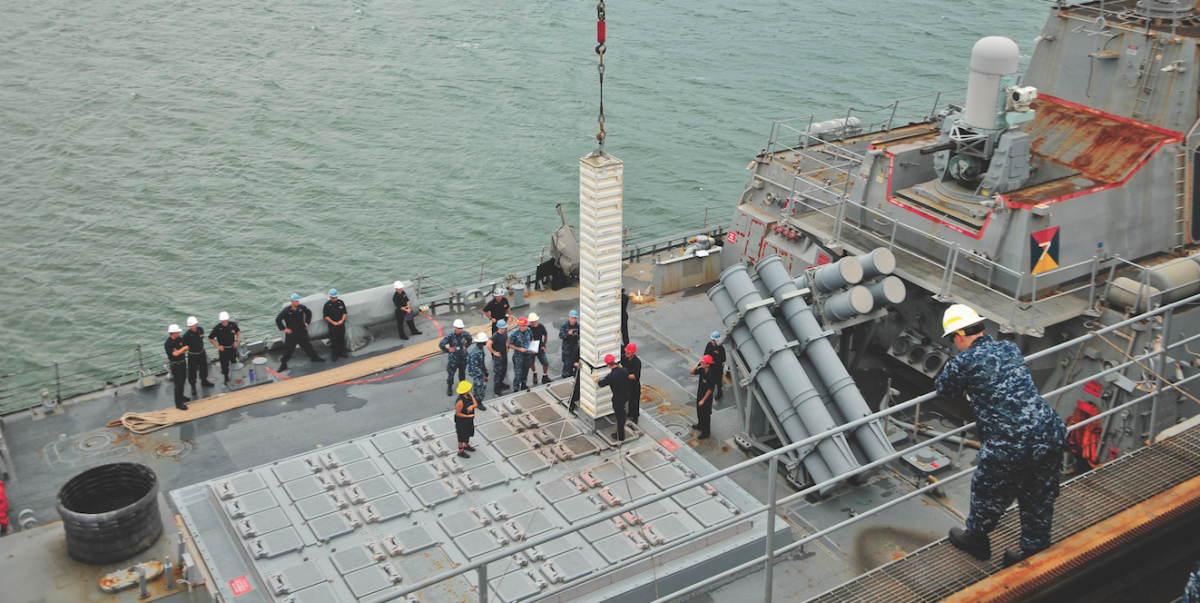
In a high-end fight, the Navy’s missile shooters will need to rearm quickly at sea. This crane from the USS Emory S. Land (AS-39) removes an expended vertical launch canister from the USS Benfold (DDG-65).
The U.S. Navy began experimenting with underway replenishment capabilities in 1899. The goal then was to enable coal-fired warships to receive fuel while under way so they could stay at sea and avoid the predictable stops at coaling stations around the globe. Today, with more than 30 ships in the combat logistics force, the U.S. fleet can be replenished at sea with fuel, ordnance, and stores so it can remain at sea almost indefinitely—with one important exception.
In his May 2013 Proceedings article, “The Rise of the Missile Carriers,” Commander Phillip Pournelle wrote, “There are current logistical limitations impeding the deployment of missiles aboard surface ships and submarines.” Navy cruisers, destroyers, and submarines must enter a port that has ordnance packaging, handling, storage, and transportation infrastructure to reload vertical launchers. In many of the world’s potential hotspots, ports that are capable of supporting missile reload are nonexistent or more than a week’s sail time away.
These reload limitations allow a potential adversary the convenience of only having to target a limited number of port facilities to eliminate the U.S. Navy’s missile rearming capabilities in any theater of conflict. Surface combatants and submarines can take two to three days to complete a missile load in port. Contingency plans exist for missile loading in forward operating areas using prepositioned assets or strategic airlift to fly in missiles, but these methods are costly, time consuming, and require a great deal of shore support to execute. To reduce sail times to reload facilities, speed up the missile reload process, and protect strategic assets, the Navy needs to develop a seagoing platform that can stow missiles vertically for transport and transfer them at sea to a combatant.
With the development of the afloat forward staging base (AFSB) ships, which are designed to support the Navy and Marine Corps sea-basing concepts, a platform now exists that could be adapted with a missile rapid reload system (MRRS) to support surface combatants and submarines. The AFSB could be adapted to having vertical cells for stowing missile canisters. With an MRRS, the AFSB could use its large vessel interface crane, which was designed to move containerized cargo from ship to ship (in up to sea state 3).
The crane’s lifting mechanisms would have to be modified slightly to handle missile canisters. The AFSB also would need a mooring system to allow it to securely mate with different classes of ships so the missile canisters could be transferred safely. The Office of
Naval Research has contracted with industry to develop the capability to moor two large vessels side by side in up to sea state 4. An AFSB with two large vessel interface cranes on each side could reload two combatants simultaneously. The AFSB also would have the capability to lower itself in the water to accommodate ships of varying freeboard.
Future conflicts will require the Navy to reload quickly. Surface combatants and submarines engaged in high-end combat could expend their missiles in a matter of days—possibly even hours. An AFSB with MRRS, including the large vessel interface crane, could reload missile shooters just outside an engagement zone, giving commanders the ability to engage an enemy and reload quickly while keeping ships close to the fight.
Lieutenant Commander Granger served for 30 years in the Navy, 15 as an aviation ordnanceman and 15 as a Supply Corps officer. For his last tour, he worked at the Navy Expeditionary Logistics Support Group in Williamsburg, Virginia, where he was the director of plans and a member of a working group with the Navy Munitions Command that studied rapid reload concepts for the Tomahawk and Standard missiles.


